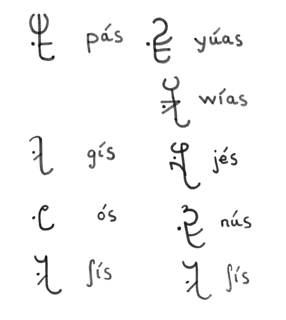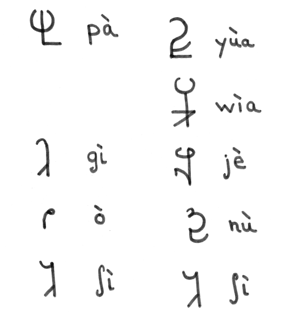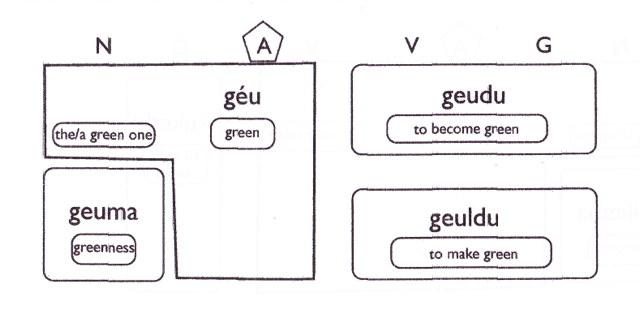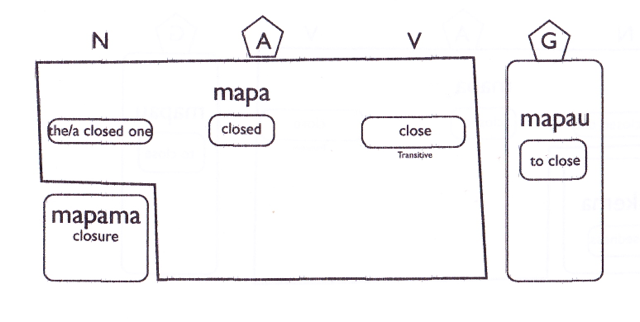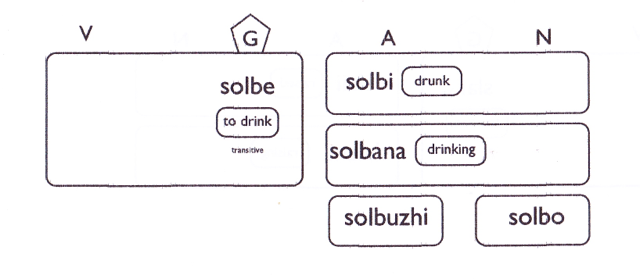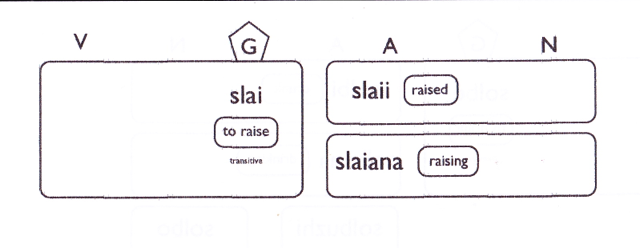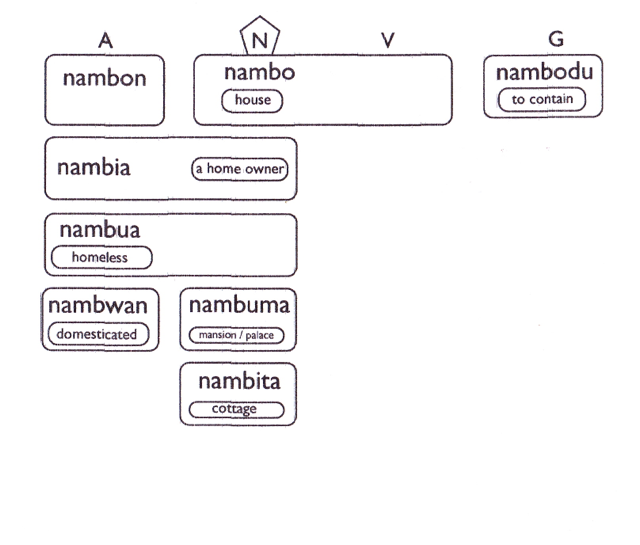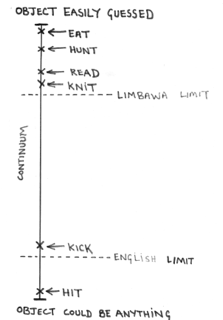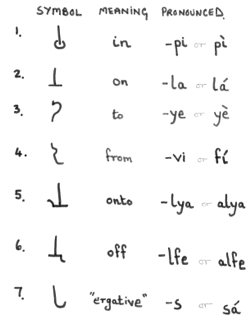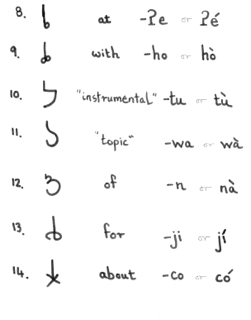Béu : Chapter 2: Difference between revisions
| Line 462: | Line 462: | ||
'''aulduri maŋkiteu''' = they blackened their faces ... interesting construction ... we use the transitive form even tho' they perform the action on themselves. | '''aulduri maŋkiteu''' = they blackened their faces ... interesting construction ... we use the transitive form even tho' they perform the action on themselves. | ||
==Verbs and how they pervade other parts of speech== | == ..... Verbs and how they pervade other parts of speech== | ||
Revision as of 06:31, 20 September 2012
..... Pronouns and what is meant by S, A and O
béu is what is called an ergative language. About a quarter of the world languages are ergative or partly ergative. So let us explain what ergative means. Well in English we have 2 forms of the first person singular pronoun ... namely "I" and "me". Also we have 2 forms of the third person singular male pronoun ... namely "he" and "him". These two forms help determine who does what to whom. For example "I hit him" and "He hit me" have obviously different meanings (in English there is a fixed word order, which also helps. In béu the word order is free).
timpa = to hit ... timpa is a verb that takes two nouns (LINGUISTIC JARGON ... a transitive verb).
pás ò timpari = I hit him pà ós timpori = He hit me ... OK in this case the protagonist marking in the verb also helps to make things disambiguous. But this will not always help, for example when both protagonists are third person singular.
So far so good. And we see that English and béu behave in the same way so far. But what happens when we take a verb that takes only one noun (LINGUISTIC JARGON ... a transitive verb). For example doika = "to walk". In English we have "he walked". However in béu we don't have *ós doikori but ò doikori (equivalent to saying "*him walked" in English). So this in a nutshell is what an ergative language is.
It is the convention to call the doer in a intransitive clause the S argument. For example òS flomporta = She has tripped
It is the convention to call the doer in a transitive clause the A argument. For example ósA timpori jene = He hit Jane
It is the convention to call the "done to" in a transitive clause the O argument. For example ò timpori jeneO = He hit Jane
The S was historically from the word "Subject" and the O historically from the word "Object", but it is best just to forget about that. In fact when I use the word "subject" I am talking about either the S argument or the A argument.
If you like you can say ;-
In English "him" is the "done to"(O argument) : "he" is the "doer"(S argument) and the "doer to"(A argument).
In béu ò is the "done to"(O argument) and the "doer"(S argument) : ós is the "doer to"(A argument).
Below are two tables showing the two forms of the béu pronouns.
| I | pás | we (includes "you") | yúas |
| we (doesn't include "you") | wías | ||
| you | gís | you (plural) | jés |
| he, she | ós | they | nús |
| it | ʃís | they | ʃís |
| me | pà | us | yùa |
| us | wìa | ||
| you | gì | you (plural) | jè |
| him, her | ò | them | nù |
| it | ʃì | them | ʃì |
There could be another member it the above table. When a action is performed by somebody on themselves, a special particle tí is used.
Just as in English, we do not say "*I hit me", but "I hit myself" ... in béu we do not say *pás pà timpari, but pás tí timpari.
LINGUISTIC JARGON ... "myself" is what is called a "reflexive pronoun". In English there are many reflexive pronouns (i.e. "myself", "yourself", "herself", etc. etc.) : in béu only one.
One other point ... béu has generally a pretty free word order. But in a sentence such as jene tí laudori (Jane washed herself) it would be pretty unusual to have the tí before jene
There is an emphatic pronouns based on the possessed form of bùa "body". The emphatic forms are given below ;-
| me myself | bapua | we ourselves | bayua |
| we ourselves | bawua | ||
| you yourself | bigua | you yourselves | bejua |
| him himself, her herself | bonua | them themselves | bunua |
| it itself | bisua | them themselves | bisua |
The above forms come just after the normal pronouns and the two words stand in apposition. If a pilana is applied to one, it must be applied to the other as well. For example ;-
pás bapuas ò timparu => I myself will hit her
..... 64 Adjectives
| good | bòi | bad | kéu |
| long | yàu | short | wái |
| high, tall | hái | low, short | ʔàu |
| happy, glad | ʔoime | sad, unhappy | heuno |
| white | ái | black | àu |
| young | sài | old (of a living thing) | gáu |
| clever, smart | jini | stupid, thick | tumu |
| near | nìa | far | múa |
| new | yaipe | old, former, previous | waufo |
| big | jutu | small | tiji |
| hot | fema | cold | pona |
| open | nava | close | mapa |
| simple, easy | baga | complex, difficult, hard | kaza |
| sharp | naike | blunt | maubo |
| wet | nuco | dry | mide |
| empty | fene | full | pomo |
| fast | saco | slow | gade |
| strong | yubu | weak | wiki |
| heavy | hobua | light | ʔekia |
| beautiful | hauʔe | ugly | ʔaiho |
| contiguous, touching | yotia | apart, separate | wejua |
| fat | somua | thin, skinny | genia |
| bright | selia | dull, dim | golua |
| thin | pilia | thick | fulua |
| east, dawn, sunrise | cúa | west, dusk, sundown | dìa |
| tight | taitu | slack, loose | jauji |
| neat | ilia | untidy | ulua |
| soft | fuje | hard | pito |
| wide/broad | juga | narrow | tisa |
| rough | gaʔu | smooth | sahi |
| deep | gubu | shallow | siki |
| right | sèu | wrong | gói |
In the above list, it can be seen that each pair of adjectives have pretty much the exact opposite meaning. However in béu there is ALSO a relationship between the sounds that make up these words.
In fact every element of a word is a mirror image (about the L-A axis in the chart below) of the corresponding element in the word with the opposite meaning.
| ʔ | ||||
| m | ||||
| y | ||||
| j | au | |||
| f | o | |||
| b | oi | |||
| g | i | |||
| d | ia | high tone | ||
| l | =========================== | a | ============================ | neutral |
| c | ua | low tone | ||
| s/ʃ | u | |||
| k | eu | |||
| p | e | |||
| t | ai | |||
| w | ||||
| n | ||||
| h |
..... Adjectives and how they pervade other parts of speech
The main parts of speech in béu are nouns, adjectives and verbs (there are also particles but they are a mixed bag, it is hard to generalise about them). However we can generalise about nouns, adjectives and verbs. Nouns (N), adjectives (A) and verbs (V) are called "parts of speech". In béu, sometimes, aNn unmodified word can belong to 2 or 3 different parts of speech at once.
For convenience I am going to introduce another part of speech : the geladi (G). You find the G-form a lot in complement clauses (that will be explained later). In our linguistic tradition we call it the infinitive form of the verb. This is the "base form" of the verb and it resembles a noun in many respects.
For example solbe means "to drink" and is a geladi. But more often you find this word in other forms. For example if you came across solbarin which means "I drank, so they say". I am counting the form solbarin as a verb (V), and the form solbe as a geladi(G). That is I am treating them as different parts of speech. This is just for convenience. I do not want to get into an argument about linguistic theories etc. etc. This is just to make things easy to discuss.
Let us start of with a single-syllable adjective. Let us see what "forms" a single-syllable adjective can take and what "parts of speech" these forms can belong to. Consider the word gèu "green" ;-
Along the top of the above chart you can see N, A, V and G. These are different part of speech. The form under these 4 headings, shows the form géu takes when it is one of these 4 parts of speech. Now géu is fundamentally an adjective (that is what that pentangle around the "A" means).
You can see that we have two nouns in the above chart. One has its original form, I call this one "the substansive noun", i.e. "the green one". The other changes its form by taking the affix -ma. I call this one "the qualitative noun", i.e. "greenness".
Now how can we tell if the unmodified géu is representing an adjective or a substansive noun. Well we can tell by its position with respect to other elements in the clause.
gèu is an adjective if it comes immediately after the copula* sàu. For example báu rì gèu => The/a man was green. (if you wanted to put a substantive after sàu, you would stick aja "one" in front of it).
gèu is also an adjective if it comes immediately after a noun i.e. báu gèu dí => This green man ((An aside ... (báu gèun dí = the green one's man here) ))
In other positions géu represents a substansive noun**.
*gèu is a qualitative noun if it comes immediately after the copula of existence gaza. For example ʔá pona => It is cold ... or ... ʔá pona paʔe => I am cold
**Well actually in one other position géu represents a qualitative noun ... after the "copula of existence" (just to make things complicated).
We can see that we can derive two verbs from géu. By affixing -du we get an intransitive verb meaning "to become green". And by affixing -ldu we get an transitive verb meaning "to make green". You can see that the V-forms and the G-forms are the same.
Actually the V-form is not geudu or geuldu. The V-form is actually a myriad of forms. But they are all built up from the geudu or geuldu foundations. As an example let us build up one of the myriad of forms that the V-form can take. First we delete the final vowel ... then we add a vowel that represents the subject ... then we add, either r, n or s (depending on if we want the indicative mood, the subjunctive nood or the imperative) ... then we add a vowel (or consonant + vowel) as a tense/aspect marker ... then we possibly add an optional evidential marker n, s or a. So we could get geudu + i + r + i +a => geudiria = "you became green, I saw it" ... one of the many forms considered as a V-form.
OK. We have seen how a single-syllable adjective works. Now for a 2-syllable adjective. Consider the word naike "sharp" ;-
We can see that in this case it is possible to have 3 parts of speech from only one form. However in this case the "finite" verb (V) is built up directly from naike and not from the G-form. So, for example, we have naikiria = "you sharpened (it), I saw you do it". Rather than *naikediria. The G-form is built up from the base form by adding the affix -du.
Notice that with géu we had two verbs generated by adding affixes. In this case we only have one verb and it is transitive.
And above we see one more possibility for a word that is fundamentally an adjective. You will see that the G form has a irregular ending. Quite a number of common adjectives act like mapa (so maybe I should not call them irregular). You will see that there is also a pentangle around the "G". This is because we can not say if this word is basically an infinitive verb or an adjective. There would be two entries in a dictionary.
Again only one verb and it is transitive. There are three ways that we can make an intransitive clause.
1) pintu tí mapori = The door closed itself ... this form strongly implies that there was no human agent. Possibly the wind closed the door (or a supernatural element when it comes to that).
2) pintu lái mapori = The door was closed ... this is the standard passive form. It strongly implies a human agent but the agent is either unknown or unimportant.
3) pintu lí mapa = The door became closed ... this uses the adjective form of mapa and the "copula of becoming" láu. This form has no implication as to the humanness of the agent.
By the way, the G-form of nava "open" is navai
Let us go back to gèu and consider gèu in an intransitive clause. As above we have 3 ways.
1) báu tí geuldori = The man made himself green ... this form implies that there was some effort involved.
2) báu lái geuldori = The man was made green ... this is the standard passive form. It strongly implies a human agent but the agent is either unknown or unimportant.
3) báu lí gèu = The man became green ... this uses the adjective form of gèu and the "copula of becoming" láu. This form has no implication as to the humanness of the agent.
And of course gèu has a fourth way ...
4) báu gèudori = The man became green
Actually 3) and 4) have the same meaning.
Any single syllable adjective, must have the suffix du in all its verbal forms. For example ;-
audu = to become black, auldu = to blacken, maŋkeu = faces
aulduri maŋkiteu = they blackened their faces ... interesting construction ... we use the transitive form even tho' they perform the action on themselves.
..... Verbs and how they pervade other parts of speech
slaii is pronounced as two syllables ... as you would say "sly "e" " ... glottal stop between the syllables ... quite easy to say.
slaianais pronounced as three syllables ... slai ... a ... na ... also easy to say.
Nouns and how they pervade other parts of speech
nambo
nambo meaning house is a fairly typical non-single-syllable noun and we can use it to demonstrate how béu generates other words from nouns.
nambodu
Not many nouns can be used as verbs. However when an action is associated to a certain noun, usually, with no change of form, it can be used as a verb. For example lotova means bicycle and you get lotovarwi meaning "I used to ride my bicycle". For the infinitive, du must be affixed to the basic form.
The meaning given to the verb nambo is arrived at through metaphor, it is not so straight forward as the bicycle example.
The use of all tools can be expressed in a similar manner to lotova.
nambon
Sometimes in English a bare noun can be used to qualify another noun (i.e. it can act as an adjective). For example in the phrase "history teacher", "history" has the roll usually performed by an adjective ... for example, "the sadistic teacher". This can never happen in béu, the noun must undergo some sort of change. The most common change for nambo is it to change into its genitive form nambon as in pintu nambon "the door of the house". Other changes that can occur are the affixation of -go or -ka. These are used with certain nouns more than others. They are not used that much with the noun nambo so I haven't included them in the chart above. You could use the forms nambogo or namboka if you wanted tho' (they would mean "house-like"). Maybe you would use one of these terms in a joke ... it would stike the listener as slightly odd however.
nambia
This is a very common derivation. Nearly all nouns can take this transformation.
nambia is an adjective meaning "having a home". And its use as a noun is quite common as well, in which case it would probably be translater as "a home owner"
nambua
Also a very common derivation. The opposite of nambia.
nambua means homeless or the homeless
Note that although ia and ua are exact opposites, the usage of the words produced from these affixes do not completely mirror each other. It all depends oner what the base word is.
For example, in this case, the form nambia is a bit rarer than nambia. Also nambua is used more often as an adjective than as a noun, while nambia is used more often as a noun than an adjective.
nambuma
Many of the worlds languages have a suffix that has this roll. Called an "augmentative" in the Western linguistic tradition. Does not really come into play in English but quite common in béu. As well as some basic forms that appear regularly in their augmentative version, any noun can receive this affix. But of course it will stick out if it is not commonly used.
nambita
The opposite of the above affix. Called an "diminutive" in the Western linguistic tradition. In béu it is often used to show that the speaker feels affection for the noun so transformed. There is no trace of the opposite for the augmentative : nobody would use the augmentative to show repulsion.
nambwan
The form changes that produce nambia, nambua, nambuma, nambita, *nambija are *nambeba affected by deleting the final vowel (or diphthong) and then adding the relevant affix. However with this change of form this is not always possible to delete the final vowel (example). In this example it is possible. In fact it is possible if the final consonant of the base word is j, b, g, d,c, s, k, t, l or m.
wan is affixed to a few nouns, a few adjectives plus a few. Its has the sense of "tending towards","accustomed to" or "addicted to".
| ái | white | aiwan | faded |
| lozo | grey | lozwan | grizzled |
| pà | I | pawan | selfish |
| mama | mother | mamwan | motherbound |
| nambo | house | nambwan | domesticated |
| toili | book | toilwan | bookish |
By the way nambwan means domestic or domesticated. Nearly always when you come across the word it is referring to animals.
Other derivations that are not possible with nambo
I have already mentioned nambogo and namboka which while possible, are not at all common. Also I will mention three other derivations that are quite common however can not occur with nambo.
1) -ija is affixed to the names of animals and give a word meaning the young of that animal. For example;-
huvu = sheep
huvija = lamb
mèu = cat
meuja = kitten
2) -eba is an affix that produces a word meaning "a set of something" where the base word is considered as a central/typical member of that set. For example;-
baiʔo = spoon
baiʔeba = cutlery
= chair
= furniture
nambeba could represent a set comprising (houses, huts, skyscrapers, apartment buildings, government buildings etc etc.), however this is already covered by bundo (derived from the verb bunda "to build").
3) -ve ... Well the status of this one can be analysed in two ways. It could be said to be the same as the affixes mentioned above. An affix that generates an adverb* with the meaning "to act in the manner of xxxx". OK the nouns that are used with this affix tend to do something (to move) and as houses do not do much, I can not demonstrate using nambo.
Let us take deuta meaning "soldier". The word deutave would be an adverb meaning "in the manner of a soldier". Note that if this is an affix. it has the form CV and hence does not overwrite the final vowel of the base word (unlike the other affixes).
An alternative way to look at this is a result of the "word-building" process (see section ???)
fé deutan means "way of a soldier" or "manner of a soldier".
Now if we follow the "word-building rules"
1) The genitive suffix n is dropped
2) The first syllable of the first word is dropped.
3) The remainder of the first word is affixed to the second word.
We get the form deutave (fé being monosyllabic, we obviously can not delete its first syllable)
Probably the first analysis is correct, and we should keep fé deutan as a noun phrase, and deutave as an adverb.
* I haven't mentioned adverbs before. They are a separate part of speech, but a part of speech that has a very marginal roll. For the most part, adverbs are the same as adjectives.
báu
..... A bit about adverbs
If an adjective comes immediately after a verb (which it normally would) it is known to be an adverb. For example saco means "slow" but if it came immediately after a verb it would be translated as "slowly". However if we add -ve to it so we get the form sacove the adverb can move around the utterance ... wherever it wants to go.
-ve can also be affixed to a noun and also produce an adverb. For example ;-
deuta means "soldier"
deutave means "in the manner of a soldier"
as in doikora deutave = he walk like a soldier
So that is basically all there is to adverbs. In the Western linguistic tradition many other words are classified as adverbs. Words such as "often" and "tomorrow" etc. etc.
In the béu linguistic tradition all these words are classified as particles, a hodge podge collection of words that do not fit into the classes of noun (N), adjective (A), verb (G) or adverb.
... Parts of speech and word order ... part 2
Now we talk about the béu noun phrase. This can be described as ;-
Quantifier1 Head2 (Adjective3 x n) Genitive4 Determiner5 Relative-clause6
1) The Quantifier is either a number or a word such as "all", "many", "a few" etc.
2) The head is usually a noun but can also be an adjective. When you come across an adjective as head of a noun phrase, its meaning is "the person/thing that is "adjective" ".
3) An adjective ... not much to say about this one, you can have as many as you like, the same as English.
4) A Genitive is made from a noun (and I guess an adjective as defined in 2) ) with an n suffix. It says that the head has some quality or relationship to the genitive.
A genitive or a genitive phrase can be considered an adjective. Ownership is also shown by the genitive, however note that when the head is a multi-syllable word and the owner is a stand alone pronoun, then ownership is shown by an infix in the actual head (see "Possessive Infixes").
5) Either dí "this", or dè "that".
6) This is a clause, beginning with tà that qualifies the head of the noun phrase.
Note ... We can have genitives and we can have "genitive phrases". A genitive phrase has no suffix, but the particle nà must be placed immediately in front of it.
The son of the king => sonda blicon
The son of the old king => sonda nà blico gáu
(can a determiner be the head ??)
The 8 possessive infixes
In the above section we learnt how to say "mine", "yours", etc. etc.. But how do we say "my", "your", etc. etc.
Well these words (which would be considered adjectives in the béu linguistic tradition) are represented by infixes. The table below shows how it works.
| my coat | kaunapu |
| our coat ("our" includes "you") | kaunayu |
| our coat ("our excludes "you") | kaunawu |
| your coat | kaunigu |
| your coat (with "you" being plural) | kauneju |
| his/her coat | kaunonu |
| their coat | kaununu |
| xxxx own coat | kaunitu |
It can be seen that the infixes are the same as the plain pronouns, but the order of the consonant and vowel are swapped over.
There could also be another entry in the table above. That is the infix -it- (this is the possessive equivalent of the reflexive pronoun tí (see above). It is probably easiest to explain -it- by way of example;-
polo hendoru kaunitu = Paul will wear his coat (To be absolutely specific "Paul will wear his own coat")
polo hendoru kaunonu = Paul will wear his coat (To be absolutely specific "Paul will wear someone else's coat")
A thing to note is that you can not insert an infix into a monosyllable word. You could not say *glapa for "my woman" but would have to say glá nà pà
The transitivity of verbs in béu
All languages have a Verb class, generally with at least several hundred members.
Leaving aside copula clauses, there are two recurrent clause types, transitive and intransitive. Verbs can be classified according to the clause type they may occur in: (a) Intransitive verbs, which may only occur in the predicate of an intransitive clause; for example, "snore" in English. (b) Transitive verbs, which may only occur in the predicate of a transitive clause; for example, "hit" in English. In some languages, all verbs are either strictly intransitive or strictly transitive. But in others there are ambitransitive (or labile) verbs, which may be used in an intransitive or in a transitive clause. These are of two varieties: (c) Ambitransitives of type S = A. An English example is "knit", as in "SheS knits" and "SheA knits socksO". (d) Ambitransitives of type S = O. An English example is "melt", as in "The butterS melted" and "SheA melted the butterO".
English verbs can be divided into the four types mentioned above. béu verbs however can only be divided into two types, a) Intransitive, and b) Transitive. In this section it will be shown how the four English types of verb map into the two béu types. (Of course there is nothing special or unique about English ... other than the fact that a reader of this grammatical sketch will already be familiar with English)
Intransitive
..
An intransitive verb in English => an intransitive verb in béu
..
An example of an intransitive verb in English is "laugh". This is also an intransitive verb in béu. In a clause containing an intransitive verb, the only argument that you have is the S argument.
By the way ... some concepts that are adjectives in English are primarily intransitive verbs in béu, for example ;- to be angry, to be sick, to be healthy etc. etc.
Ambitransitive of type S=O
..
| x) An intransitive in béu | |
| An "ambitransitive of type S=O" => | y) A pair of verbs, one being intransitive and one being transitive |
| z) A transitive in béu |
..
x) "Ambitransitive verbs of type S=O" which have greater frequency in intransitive clauses, are intransitive verbs in béu.
For example ;- flompe = to trip, (ò)S flomporta = She has tripped
y) "Ambitransitive of type S=O" verbs which are frequent in both transitive and intransitive clauses, are represented as a pair of verbs in béu, one of which is intransitive and one transitive. There are a few hundred béu verbs that come in pairs like this. One should not be thought of as derived from the other; each form should be considered equally fundamental. All the pairs have the same form, except the transitive one has an extra "l" before its final consonant.
For example hakori kusoniS = his chair broke : (pás)A halkari kusoniO = I broke his chair :
z) "Ambitransitive of type S=O" verbs which have greater frequency in transitive clauses, are transitive vebs in béu.
For example ;- nava = to open, (pás)A navaru pintoO = I am going to open the door
Ambitransitive verbs of type S=A and Transitive verbs
. .
| An "ambitransitive of type S=A" | |
| or | => A transitive in béu |
| A transitive verb in English |
. .
I am taking transitive and ambitransitive of type (S=A) together as I consider them to be basically the same thing but tending to opposite ends of a continuum.
Consider the illustration below.
At the top (with the "objects easily guessed") are verbs that are normally designated "ambitransitive of type S=A".
At the bottom (with the "objects could be anything") are verbs that are normally designated "transitive".
.
.
Considering the top first. One can have "IA eat applesO" or we can have "IS eat"
Then considering the bottom. One can have "IA hit JaneO" but you can not have "*IS hit"
Moving up from the bottom. One can imagine a situation, for example when showing a horse to somebody for the first time when you would say "SheS kicks". While this is possible to say this, it is hardly common*.
As we go from the top to the bottom of the continuum;-
a) The semantic area to which the object (or potential object if you will) gets bigger and bigger.
b) At the bottom end the object becomes is more unpedictable and hence more pertinent.
c) As a consequence of a) and b), the object is more likely to be human as you go down the continuum.
béu considers it good style to drop as many arguments as possible. In béu all the verbs along this continuum are considered transitive. Quite often one or both arguments are dropped, but of course are known through context. If the O argument is dropped it could be known because it was the previously declared topic (however more often the A argument is the topic tho', and hence dropped, represented by swe tho' as its case marking can not be dropped), it could be because the verb is from the top end of the continuum and the action is the important thing and the O argument or arguments just not important, or the dropped argument could be interpreted as "something" or "somebody", or it could be a definite thing that can be identified by the discouse that the clause is buried in.
* In béu "She kicks" would be ò (rà) lugaʃi from luga = "to kick" and the suffix ʃi, meaning "to tend to", "to be liable to" . .
Introduction to the PILANA
..
These are what in LINGUISTIC JARGON are called "cases". The classical languages, Greek and Latin had 5 or 6 of these. Modern-day Finnish has about 15 (it depends on how you count them, 1 or 2 are slowly fading away). Present day English still has a relic of a once more extensive case system : most pronouns have two forms. For example ;- the third-person:singular:male pronoun is "he" if it represents "the doer", but "him" if it represents "the done to".
The word pilana is built up from ;-
pila = to place, to position
pilana <= (pila + ana), in LINGUISTIC JARGON it is called a "present participle". It is an adjective which means "putting (something) in position".
As béu adjectives freely convert to nouns*, it also means "that which puts (something) in position" or "the positioner".
Actually only a few of them live up to this name ... nevertheless the whole set of 14 are called pilana in the béu linguistic tradition.
..
The pilana are suffixed to nouns and specify the roll these nouns play in the clause**.
The pilana are abbreviated to a single consonant in the béu writing system. That is, in the béu writing system, the final vowel of all pilana is invisible***.
The pilana are partly an aid to quicker writing. However they also demarcate a set of 14 affixes and make quite a neat system.
You could call these 14 plus the unmarked noun a case system of 15 cases. Well you could if you wanted to (up to you).
Note that -lya and -lfe are represented by a special amalgamated symbols which do not occur elsewhere.
Notice that by a addition of pilana, you might expect to get the forms alye and alfi. As you can see this is not the case. Perhaps the amalgamated form has the final vowel changed under the pull of the initial vowel, a.
* You can tell if pilana is being an adjective or a noun by the environment that you find it in.
** Well actually that is not true of pilana number 12 : "-n" modifies a noun in a noun phrase.
***Maybe a corollary of the béu habit of dropping verbal arguments, when it is at all possible :-)
Now one quirk of the pilana, something that I think would not happen in a natural language, is that if the noun receiving the pilana is more than one word long*, then the pilana changes from a suffix to a preposition. The prepositional forms of the pilana are given on the above chart to the right. These free-standing particles are also written just using the symbols given on the above chart to the left. That is in writing they are shorn of their vowels as their affixed counter-parts are.
The letters m, b, k, g and d are free to be used as abbreviations. Perhaps m <= mò, two particles for joining clauses etc. etc.
*Another case when the pilana come as prepositions is when the noun ends in a constant. This happens very, very rarely but it is possible. For example toilwan is an adjective meaning "bookish". And in béu as adjectives can also act as nouns in certain positions, toilwan would also be a noun meaning "the bookworm".
The relative clause
béu has a relative clause construction which works in pretty much the same way as the English relative clause construction. A relative clause is a clause that qualifies a noun. It is introduced by a special particle, tà in béu. In English it is usually "that" but a number of other words can also be used. The noun that is being qualified is dropped from the relative clause, but the roll which it would play is shown by its pilana on the relativizer tà. For example ;-
glá tà bwàs timpori rà hauʔe = The woman that the man hit, is beautiful. ... If the clause that is qualifying the noun appeared in isolation, it would be - bwàs timpori glá ... glá is the O argument and hence is unmarked.
glá tà flompori rà hauʔe = The woman that tripped is beautiful. ... If the clause that is qualifying the noun appeared in isolation, it would be - glá flompori ... glá is the S argument and hence is unmarked.
bwà tàs timpori glá rà ʔaiho = The man that hit the woman is ugly. ... If the clause that is qualifying the noun appeared in isolation, it would be - bwàs timpori glá ... bwà is the A argument and hence has pilana number 7 "-s", which is transferred to the relativized tà when bwà disappears.
The same thing happens with all the pilana*. For example ;-
the basket tapi the cat shat was cleaned by John.
the wall tala you are sitting was built by my grandfather.
the woman taye I told the secret, took it to her grave.
the town tavi she has come is the biggest south of the mountain.
the lilly pad talya the frog jumped was the biggest in the pond.
the boat talfe you have just jumped is unsound
bwà tàs timpori glá rà ʔaiho = The man that hit the woman is ugly.
nambo taʔe she lives is the biggest in town.
bwà taho ò is going to market is her husband.
the knife tatu he severed the branch is a 100 years old
the man tan dog I shot, reported me to the police = the man whose dog I shot, reported me to the police**
The old woman taji I deliver the newspaper, has died.
The boy taco they are all talking, has gone to New Zealand.
* Well all the pilana except -wa. This pilana sets the noun it qualifies to the status of "topic". The time for which a noun will retain its "topicality" is usually much longer than a clause.
**Altho' this has the same form as all the rest, underneath there is a difference. n marks a noun as part of a noun phrase, not as to its roll in a clause.
The topic marker "wa" and the discourse strategy of dropping the topic.
English has what Dixon calls a S/A pivot construction. What that means is you can drop the A argument or the S argument if it is the same as the A argument or S argument in the previous clause. For example ;-
1) You can drop the A if it is the same as the S in the previous clause ... John saw Mary: John laughed => John saw Mary and laughed
2) You can drop the A if it is the same as the A in the previous clause ... John saw Mary : John hit Bill => John saw Mary and hit Bill
3) You can drop the S if it is the same as the S in the previous clause ... John entered : John sat down => John entered and sat down
4) You can drop the S if it is the same as the A in the previous clause ... John entered : John saw Mary => John entered and saw Mary
A small number of languages have a S/O pivot. That is you can drop the S argument or the O argument if it is the same as the S argument or O argument in the previous clause. (the Australian language Dyirbal is one example of this type of language).
Anyway, the above is just some side-information that I am giving you. béu has what I call a declared pivot construction. The "pivot" (or topic) in a discourse must be stated and from that point on all reference to that "pivot" is dropped, until a new "pivot" is declared.
You declare the topic by affixing wa to it when it is in S, A or O function. If it is in A function that the topic is declared then the s (ergative marker) is dropped. (However in the clause in which you declare a pivot can not have any dropped arguments ... if it is a transitive verb in the clause, and there in no argument with the ergative marker, then you can work out that it must be the argument marked by wa which is the A argument). From then on the topic is dropped until a new topic is declared. For example;-
1) giant.wa destroyed the castle on the hill
2) Then ø came down into the valley
3) There ø met a dwarf doing good works
4) The dwarf turned ø to stone
5) Dwarf.wa then climbed the mountain
6) ø gave succour to the people from the castle ...
It is the rule that the topic must be dropped. if the topic appears in a peripheral roll (pilana 1-> 14) then that pilana is attached to the verb.
For example ;-
1) Last night I saw Thomas
2) Thomas.wa (or o.wa) was very drunk
3) Mary had given.ye a bottle of Chevas Regal
How does this system mesh in with passives ? Particles that appear between clauses ? Particles that change the subject ?
You can see from 4) above, that this just doesn't work if you have labile verbs. In English "turned" is called a labile verb (ambitransitive is another name for this). That means it can be used in a transitive clause and in an intransitive clause. Foer example ;-
1) The dwarf turned the giant to stone ... transitive
2) The dwarf turned to stone ... intransitive
Changing transitivity
béu has 2 morphological ways to make all these type of verbs into transitive verbs ( see -at- and -az- causatives).
-AT- and -AZ-
tonzai = to awaken
tonzatai = to wake up somebody (directly) i.e. by shaking them
tonzazai = to wake up somebody (indirectly) i.e. by calling out to them
henda = to put on clothes
hendata = to dress somebody (for example, how you would dress a child)
hendaza = to get somebody to dress (for example, you would get an older child to dress by calling out to them)
The above methods of making a causative only apply to intransitive verbs. To make an transitive clause onto a causative the same method is used as English used. That is the entire transitive clause becomes a complement clause of the verb "to make".
In addition to the causative infixes shown above, there are many verb pairs such as poi = to enter, ploi = to put in, gau = to rise, glau = to raise, sai = to descend, slai = to lower
and in multisyllable words ... laudo = to wash (oneself), lauldo = to wash (something). The above are not really considered causatives. The infixing of the l is by no means productive. In fact you can not call it "infixing". Also in many cases the transitive verb out of the pair is more common than the intransitive one.
Note;- The way you say "allow" or "let" in béu is to use the gambe along with the hái "give".
I let her go => hari liʔa oye
The copula's
The 2 verbs sàu and gaza are special verbs. (LINGUISTIC JARGON ... They are called copulas... in Latin "copulare" meant "to tie", so a copula is a verb that ties. In béu they differ from normal verbs, in that they require a specific word order. Also s (the ergative case) is never suffixed to a noun, as normally happens when a verb is associated with two nouns.
GAZA .... a copula of existence
The copula complement of gaza ia always a noun or a noun phrase. It is how you say "there is ... "
gaza is similar to sàu in that it takes the 9 verb modifiers but 3 of them are wildly irregular. It is the same 3 tense/aspect forms that are irregularin the sàu copula. Namely ;-
*gazora => ʕá meaning "there is"
*gazori => ʕái meaning "there was"
*gazoru => ʔáu meaning "there will be"
Actually while theoretically gaza can have the full range of modifiers enjoyed by a normal verb, in reality all forms other than ʕá, ʕái, ʔáu are extremely rare. Occasionally you come across the "infinitive" gaza.
There is no word that corresponds to "have". The usual way to say "I have a coat" is "there exists a coat mine" = ʕá kaunu nà pà
Internal possessives are not allowed in the nouns introduced with gaza. That is, you can not say *ʔá kaunapu, but must say ʔá kaunu nà pà (I have a coat)
As I said above, gaza always comes with one noun. If it comes with an adjective, then that adjective can be considered a noun (well this is one way to look at it)
Also note that when the noun is a noun as opposed to an adjective, ??? , it is always indefinite.
pona = cold (an adjective), ponama = coldness (a noun)
ʔá pona = "it is cold" ... not *ʔá ponama
ʔá pona paye meaning "I feel cold" (word for word ... "there is coldness to me")
There is fixed word order : it is always gaza followed by the noun or NP.
The three irregular forms have their own negative marker. ya is stuck on to the end of the copula.
ʔaya pona = "it is not cold"
Note that the word ʔaya (there is not) and ʔaiya (there was not) are very close to each other phonetically. However the middle part of the second word takes twice as long as the middle part in the first word : they are phonetically quite distinct.
The particles lói (probably) and màs (maybe) normally, come before the verb that they qualify. However the 3 irregular forms of gaza really like to come clause initially. Hence lói and màs immediately follow the verb.
ʔáu lói pona = It will probably be cold
Also the evidentials are affixed to the wild forms, just as normal.
ʔaunya lói pona = They say it will probably not be cold
ʔaunya.foi lói pona = Do they say it will probably not be cold ?
SAU ....... the main copula
sàu is the béu copula. That is it is the equivalent of "to be" in English, whish has such forms as "be", "is", "was", "were" and "are".
This verb is slightly irregular in béu as well. The three forms *sari, *saru and *sara which you would expect to see, are replaced with rì, rù and rà
Notice that person and number is not included in these three irregular forms, so it is sometimes necessary to have a pronoun in situations where it would normally be dropped.
Actually rà is usually missed out completely.
It is mostly used for emphasis; like when you are refuting a claim
Person A) ... gì mò rà moltai = You aren't a doctor
Person b) ... pà rà moltai = I am a doctor
Notice that rà is always used when you have mò the negative particle. This particle must always be directly in front of a verb, so rà must be expressed.
Another situation where rà tends to be used is when the subject or the copula complement are long trains of words. For example ????????
The evidentials are appended to the wild forms as normal. So we have ràn, ràs, rìn, rià, rìs, rùn and rùs.
LAU ....... the copula of change
láu = to become, to get, recieve
lí = became
lá = becomes
lú = will become
hái = to give
láu hauʔe = to become beautiful OR to become a beautiful woman
jene lái timporu jono.vi = Jane will be hit by John
hái tí (sàu) haiʔe = to make yourself (to be) beautiful
hái jene flompe = to make Jane trip
hái jono.ye timpa jene = to make John trip Jane ... note that the A argument takes the pilana -ye.
-pi or pì : pilana naja ... (the first pilana)
meu (rà) "basket"pi
While the original meaning was about space, this pilana is very often found referring to time.
I read the book hourpi => I read the book in an hour
I gets dark pi ten minutes => It get dark in ten minutes
She qualified as a doctor pi five years
One can get from Glasgow to London daypi
I'm coming to Sweden pi next month
meu (rà) topla basketn = The cat is on top of the house
meu (rà) interior basketn = the cat is in the basket
-la or lá : pilana nauva ... (the second pilana)
mat (rà) floorla => the mat is on the floor ... notice "the mat"
ʔá mat floorla => there is a mat on the floor ... notice "a mat"
meu (rà) top.la nambo.n => The cat is on top of the house
ʔaya "money" nà pà => I don't have any money ... notice that "money" is indefinite ...
Do I need the three copula's ? ... how quickly would they collapse to two or one ?
-ye or yè : pilana naiba ... (the third pilana)
xxx yyy oye = give the book to her
xxx yyy paye = tell me about it
This is the pilana used for marking the receiver of a gift, or the receiver of some knowledge.
However the basic usage of the word is directional.
*namboye => nambye = "to the house"
.
ye "distance" nà nambo = "as far as the house"
ye "limit" nà nambo = "up to the house" ... this usage is not for approaching humans however ... for that you must use "face".i.e. ye "face" nà báu = right up to the man
.
"direction" nà nambo = towards the house i.e. you don't know if this is his destination but he is going in that direction
yèu = to arrive ... yài a SVC meaning "to start" ... fái a SVC meaning "to stop" ???
Index
- Introduction to Béu
- Béu : Chapter 1 : The Sounds
- Béu : Chapter 2 : The Noun
- Béu : Chapter 3 : The Verb
- Béu : Chapter 4 : Adjective
- Béu : Chapter 5 : Questions
- Béu : Chapter 6 : Derivations
- Béu : Chapter 7 : Way of Life 1
- Béu : Chapter 8 : Way of life 2
- Béu : Chapter 9 : Word Building
- Béu : Chapter 10 : Gerund Phrase
- Béu : Discarded Stuff
- A statistical explanation for the counter-factual/past-tense conflation in conditional sentences
